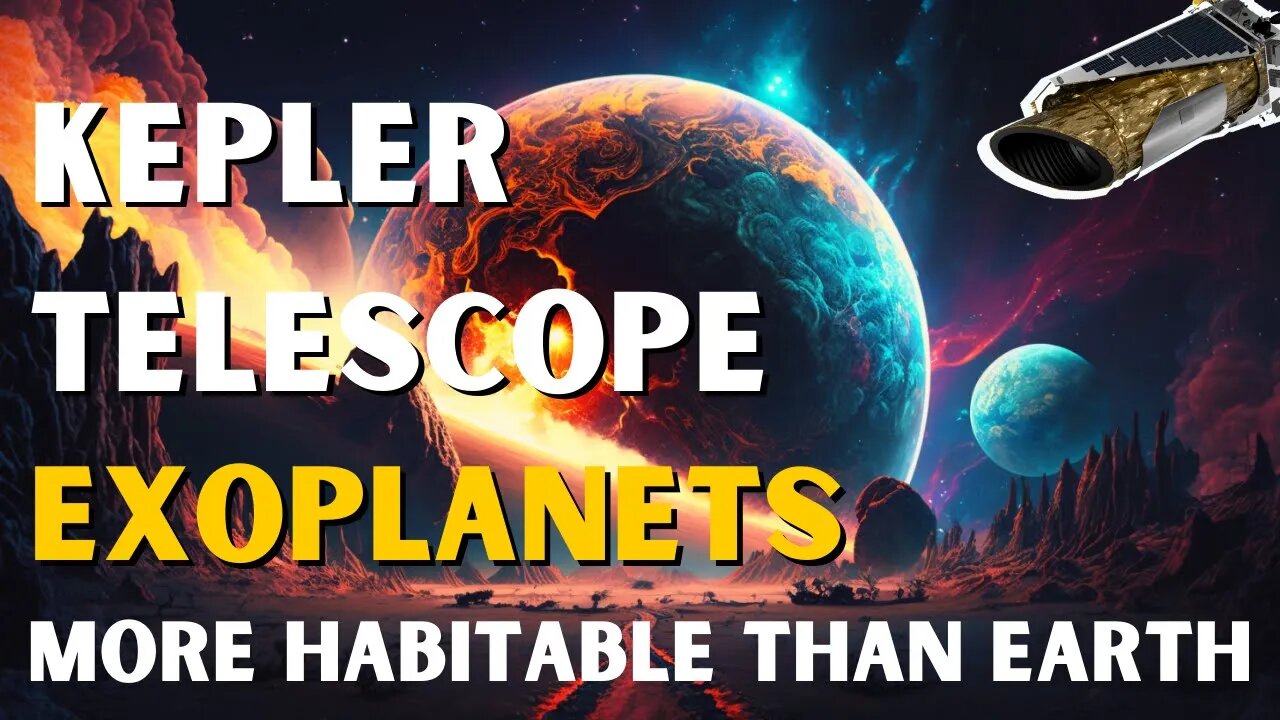Premium Only Content

NASA's Kepler Telescope Unveils Exoplanets More Habitable Than Earth
NASA's Kepler Telescope Unveils Exoplanets More Habitable Than Earth
In the vast expanse of space, the Kepler Space Telescope has played a crucial role in our quest to understand the universe. Since its launch in 2009, the Kepler Space Telescope has revolutionized our understanding of exoplanets, planets beyond our solar system.
Subscribe @Dailydoseoffact
In its nine-year mission, what if I told you that the telescope that was able to discover thousands of planets beyond our solar system, and even detect some of their atmospheres?
It has found thousands of exoplanets, planets outside our solar system, and has shed light on the possibility of extra-terrestrial life.
For nearly a decade, Kepler peered into the vast expanse of space, searching for tiny dips in brightness that could reveal the presence of planets orbiting distant stars. And what it found was nothing short of astonishing.
Its discoveries have challenged our beliefs about the universe and given us a glimpse into the possibility of life beyond our own planet. In this video, we will dive into the Kepler Space Telescope and the remarkable exoplanets it has found, unlocking the secrets of our universe.
Join me as we dive into the incredible journey of the Kepler Space Telescope and the discoveries it has made.
The discovery of exoplanets has opened a whole new world of possibilities in our quest for understanding the universe. The different types of exoplanets that have been discovered so far offer a glimpse into the diverse nature of planetary systems in our galaxy.
From gas giant planet that orbits very close to its star which planets have scorching temperatures and extreme weather conditions, including violent storms and winds. Another type of exoplanet is the Super-Earth, which is a planet that has a mass and radius between that of Earth and Neptune. Super-Earths are often rocky and may have liquid water on their surface, making them potential candidates for habitability.
The Earth-like exoplanets are planets that are similar in size and composition to Earth. These planets could potentially have similar climates and environments to Earth, making them strong candidates for habitability.
One of the most notable exoplanets discovered by the Kepler Space Telescope is Kepler-452b. This planet is about 1.6 times the size of Earth and is located in the habitable zone of its star, which means it could have liquid water on its surface. This discovery was particularly exciting as it represents one of the best candidates for finding extraterrestrial life.
Another interesting exoplanet discovered by the Kepler Space Telescope is Kepler-16b, which is a gas giant that orbits two stars, much like the fictional planet Tatooine from the Star Wars franchise. This was the first time a planet had been discovered orbiting two stars, and it has led to a greater understanding of the potential for planetary systems to exist in multiple-star systems.
Kepler-22b is another noteworthy exoplanet discovered by the Kepler Space Telescope. It is about 2.4 times the size of Earth and is located in the habitable zone of its host star. This exoplanet was particularly exciting as it was the first confirmed planet in the habitable zone of a sun-like star, which increased the possibility of finding other potentially habitable planets in the future.
In addition to these exoplanets, the Kepler Space Telescope has also discovered a variety of other interesting planetary systems, including planets with extremely short orbital periods, planets with unusual orbits, and planets with strange compositions.
Overall, the Kepler Space Telescope has been a game-changer in the search for exoplanets and has greatly expanded our understanding of the diversity and prevalence of planets in our galaxy. Its discoveries have paved the way for future missions, such as NASA's upcoming James Webb Space Telescope, which will be able to study the atmospheres of exoplanets in greater detail and potentially detect signs of life on other planets.
--------
"NASA's Kepler Telescope Unveils Exoplanets More Habitable Than Earth!"
"Breaking News: Kepler Discovers New Planets Teeming with Life Potential"
"Exoplanet Extravaganza: NASA Finds Worlds Surpassing Earth's Habitability"
"Life Beyond Earth: Kepler Telescope's Groundbreaking New Planet Discoveries"
"NASA's Big Reveal: Exoplanets Even More Perfect for Life Than Our Home Planet"
"Kepler's Epic Discovery: Unveiling New Planets That Could Host Advanced Life"
"The Great Exoplanet Hunt: NASA's Kepler Telescope Finds Life's New Frontier"
"Kepler's Cosmic Breakthrough: New Planets with Unprecedented Potential for Life"
"Discovering Earth's Superior Twins: NASA's Kepler Telescope Uncovers New Worlds"
"NASA's Kepler Finds Game-Changing Exoplanets: Welcome to Our Future Galactic Homes"
-
 LIVE
LIVE
Matt Kohrs
9 hours agoMarket Open: BIG Moves Incoming?!?! || Live Trading
521 watching -
 LIVE
LIVE
JuicyJohns
40 minutes ago🟢#1 REBIRTH PLAYER 10.2+ KD🟢
205 watching -
 LIVE
LIVE
Wendy Bell Radio
4 hours agoDemocrats Are In Total Free Fall
5,692 watching -
 54:23
54:23
Dialogue works
2 days ago $0.33 earnedAndrei Martyanov: Putin Beating Trump at His Own Game - Can Israel Survive a War W/ Iran W/o the US?
9767 -
 LIVE
LIVE
LFA TV
2 hours agoLFA TV ALL DAY STREAM - MONDAY 8/18/25
6,312 watching -
 58:23
58:23
JULIE GREEN MINISTRIES
2 hours agoJUDGEMENT IN DC IS ABOUT TO INTENSIFY
42.1K117 -
 LIVE
LIVE
Chicks On The Right
3 hours agoLibs freak over Putin meeting, Rubio SHINES, Gavin spiraling, Kamala drunk-talks again
1,881 watching -
 LIVE
LIVE
Welcome to the Rebellion Podcast
18 hours agoA Case of the MonJays - WTTR Podcast Live 8/18
139 watching -
 LIVE
LIVE
The Bubba Army
2 days agoZelensky SLAMS Trump-Putin Meeting - Bubba the Love Sponge® Show | 8/18/25
2,724 watching -
 LIVE
LIVE
PudgeTV
10 hours ago🔵 StarCraft 2 Live Gaming on Rumble | Can the Terran Survive the Protoss Master Race?
473 watching